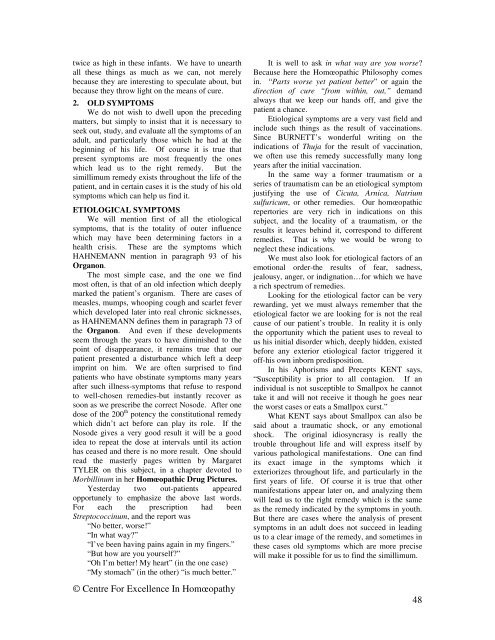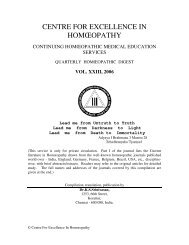Create successful ePaper yourself
Turn your PDF publications into a flip-book with our unique Google optimized e-Paper software.
twice as high in these infants. We have to unearth<br />
all these things as much as we can, not merely<br />
because they are interesting to speculate about, but<br />
because they throw light on the means of cure.<br />
2. OLD SYMPTOMS<br />
We do not wish to dwell upon the preceding<br />
matters, but simply to insist that it is necessary to<br />
seek out, study, and evaluate all the symptoms of an<br />
adult, and particularly those which he had at the<br />
beginning of his life. Of course it is true that<br />
present symptoms are most frequently the ones<br />
which lead us to the right remedy. But the<br />
simillimum remedy exists throughout the life of the<br />
patient, and in certain cases it is the study of his old<br />
symptoms which can help us find it.<br />
ETIOLOGICAL SYMPTOMS<br />
We will mention first of all the etiological<br />
symptoms, that is the totality of outer influence<br />
which may have been determining factors in a<br />
health crisis. These are the symptoms which<br />
HAHNEMANN mention in paragraph 93 of his<br />
Organon.<br />
The most simple case, and the one we find<br />
most often, is that of an old infection which deeply<br />
marked the patient’s organism. There are cases of<br />
measles, mumps, whooping cough and scarlet fever<br />
which developed later into real chronic sicknesses,<br />
as HAHNEMANN defines them in paragraph 73 of<br />
the Organon. And even if these developments<br />
seem through the years to have diminished to the<br />
point of disappearance, it remains true that our<br />
patient presented a disturbance which left a deep<br />
imprint on him. We are often surprised to find<br />
patients who have obstinate symptoms many years<br />
after such illness-symptoms that refuse to respond<br />
to well-chosen remedies-but instantly recover as<br />
soon as we prescribe the correct Nosode. After one<br />
dose of the 200 th potency the constitutional remedy<br />
which didn’t act before can play its role. If the<br />
Nosode gives a very good result it will be a good<br />
idea to repeat the dose at intervals until its action<br />
has ceased and there is no more result. One should<br />
read the masterly pages written by Margaret<br />
TYLER on this subject, in a chapter devoted to<br />
Morbillinum in her Homœopathic Drug Pictures.<br />
Yesterday two out-patients appeared<br />
opportunely to emphasize the above last words.<br />
For each the prescription had been<br />
Streptococcinum, and the report was<br />
“No better, worse!”<br />
“In what way?”<br />
“I’ve been having pains again in my fingers.”<br />
“But how are you yourself?”<br />
“Oh I’m better! My heart” (in the one case)<br />
“My stomach” (in the other) “is much better.”<br />
© Centre For Excellence In Homœopathy<br />
It is well to ask in what way are you worse?<br />
Because here the Homœopathic Philosophy comes<br />
in. “Parts worse yet patient better” or again the<br />
direction of cure “from within, out,” demand<br />
always that we keep our hands off, and give the<br />
patient a chance.<br />
Etiological symptoms are a very vast field and<br />
include such things as the result of vaccinations.<br />
Since BURNETT’s wonderful writing on the<br />
indications of Thuja for the result of vaccination,<br />
we often use this remedy successfully many long<br />
years after the initial vaccination.<br />
In the same way a former traumatism or a<br />
series of traumatism can be an etiological symptom<br />
justifying the use of Cicuta, Arnica, Natrium<br />
sulfuricum, or other remedies. Our homœopathic<br />
repertories are very rich in indications on this<br />
subject, and the locality of a traumatism, or the<br />
results it leaves behind it, correspond to different<br />
remedies. That is why we would be wrong to<br />
neglect these indications.<br />
We must also look for etiological factors of an<br />
emotional order-the results of fear, sadness,<br />
jealousy, anger, or indignation…for which we have<br />
a rich spectrum of remedies.<br />
Looking for the etiological factor can be very<br />
rewarding, yet we must always remember that the<br />
etiological factor we are looking for is not the real<br />
cause of our patient’s trouble. In reality it is only<br />
the opportunity which the patient uses to reveal to<br />
us his initial disorder which, deeply hidden, existed<br />
before any exterior etiological factor triggered it<br />
off-his own inborn predisposition.<br />
In his Aphorisms and Precepts KENT says,<br />
“Susceptibility is prior to all contagion. If an<br />
individual is not susceptible to Smallpox he cannot<br />
take it and will not receive it though he goes near<br />
the worst cases or eats a Smallpox curst.”<br />
What KENT says about Smallpox can also be<br />
said about a traumatic shock, or any emotional<br />
shock. The original idiosyncrasy is really the<br />
trouble throughout life and will express itself by<br />
various pathological manifestations. One can find<br />
its exact image in the symptoms which it<br />
exteriorizes throughout life, and particularly in the<br />
first years of life. Of course it is true that other<br />
manifestations appear later on, and analyzing them<br />
will lead us to the right remedy which is the same<br />
as the remedy indicated by the symptoms in youth.<br />
But there are cases where the analysis of present<br />
symptoms in an adult does not succeed in leading<br />
us to a clear image of the remedy, and sometimes in<br />
these cases old symptoms which are more precise<br />
will make it possible for us to find the simillimum.<br />
48




